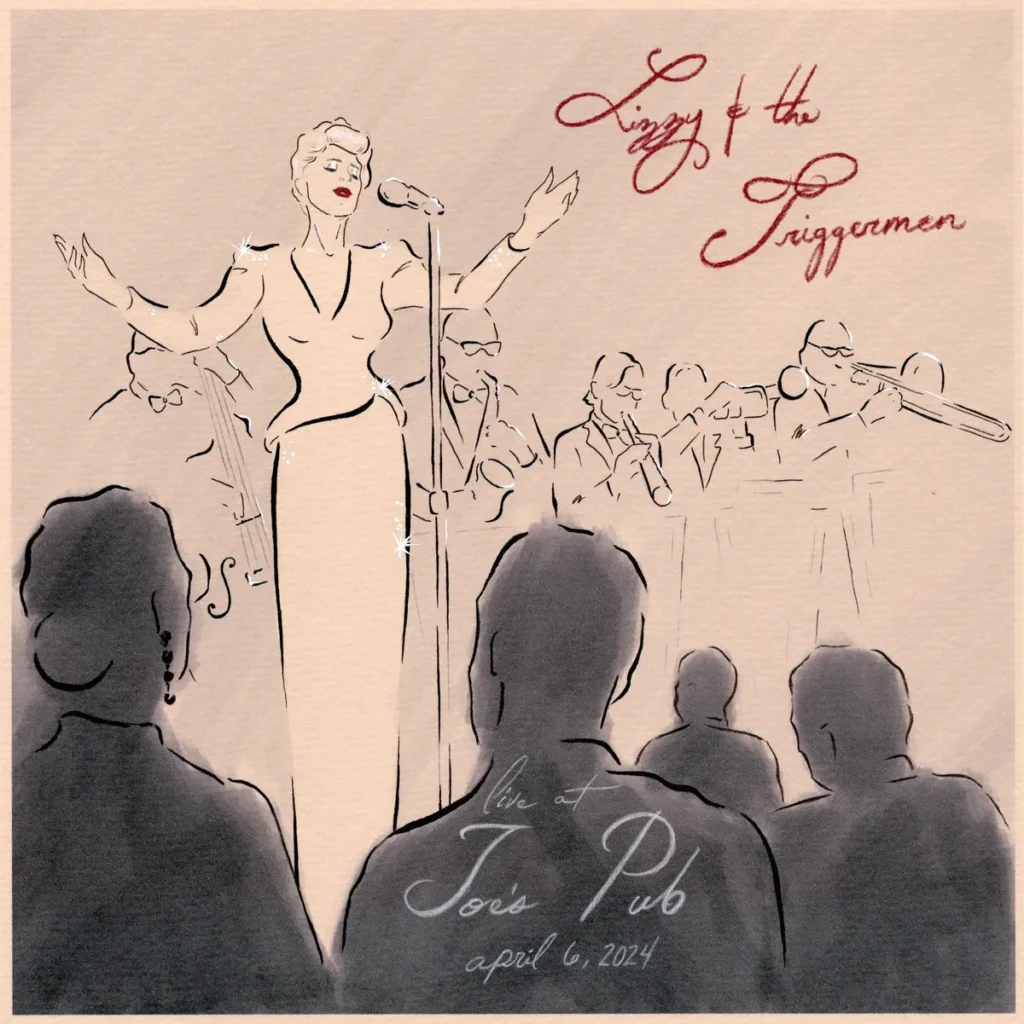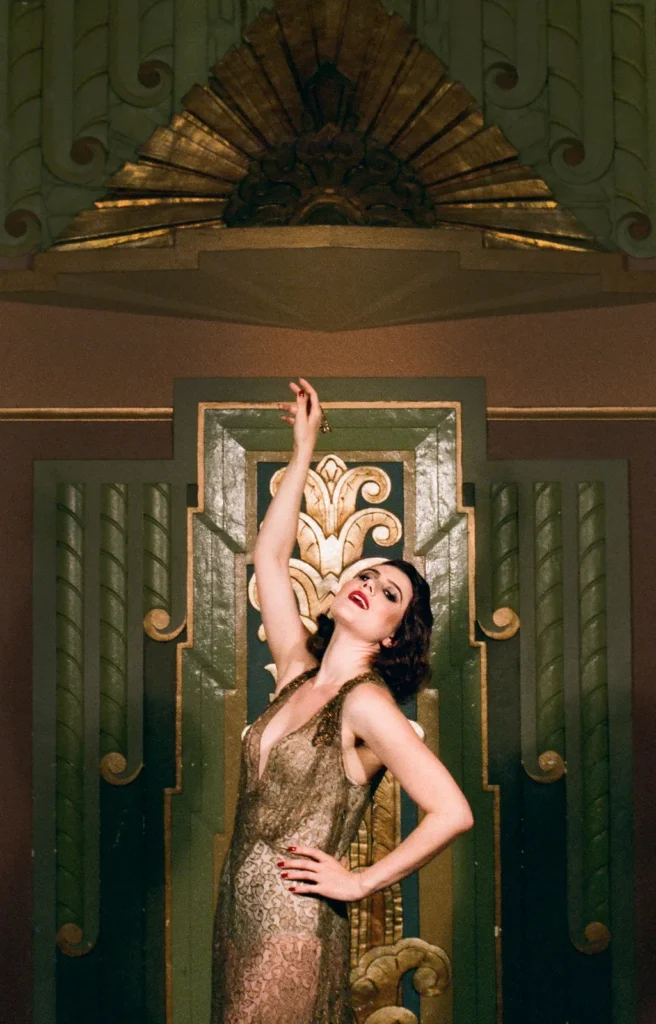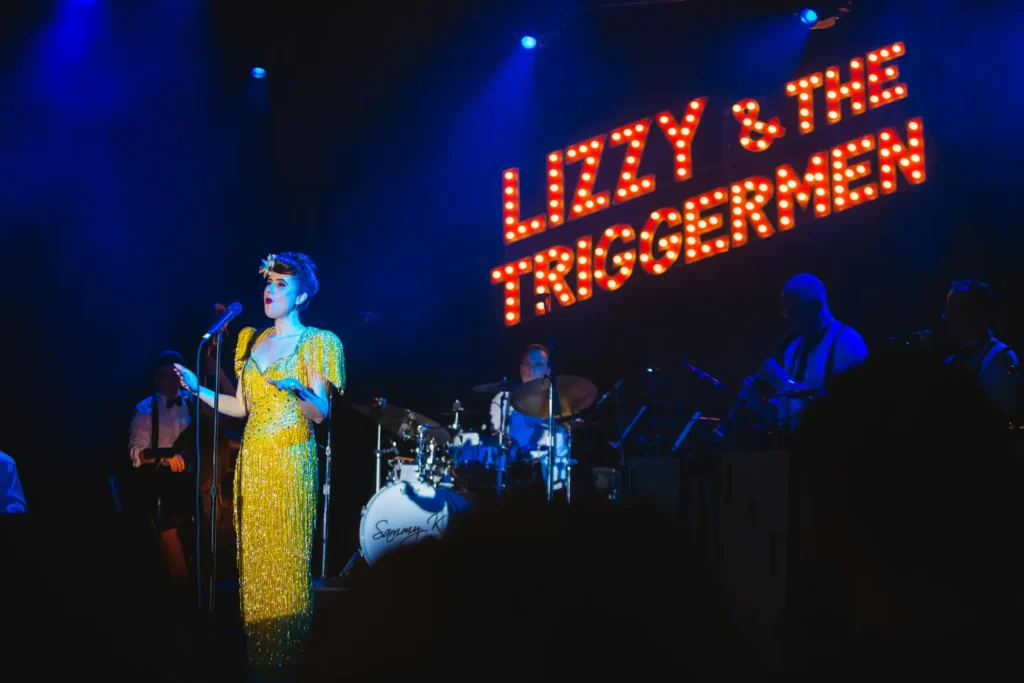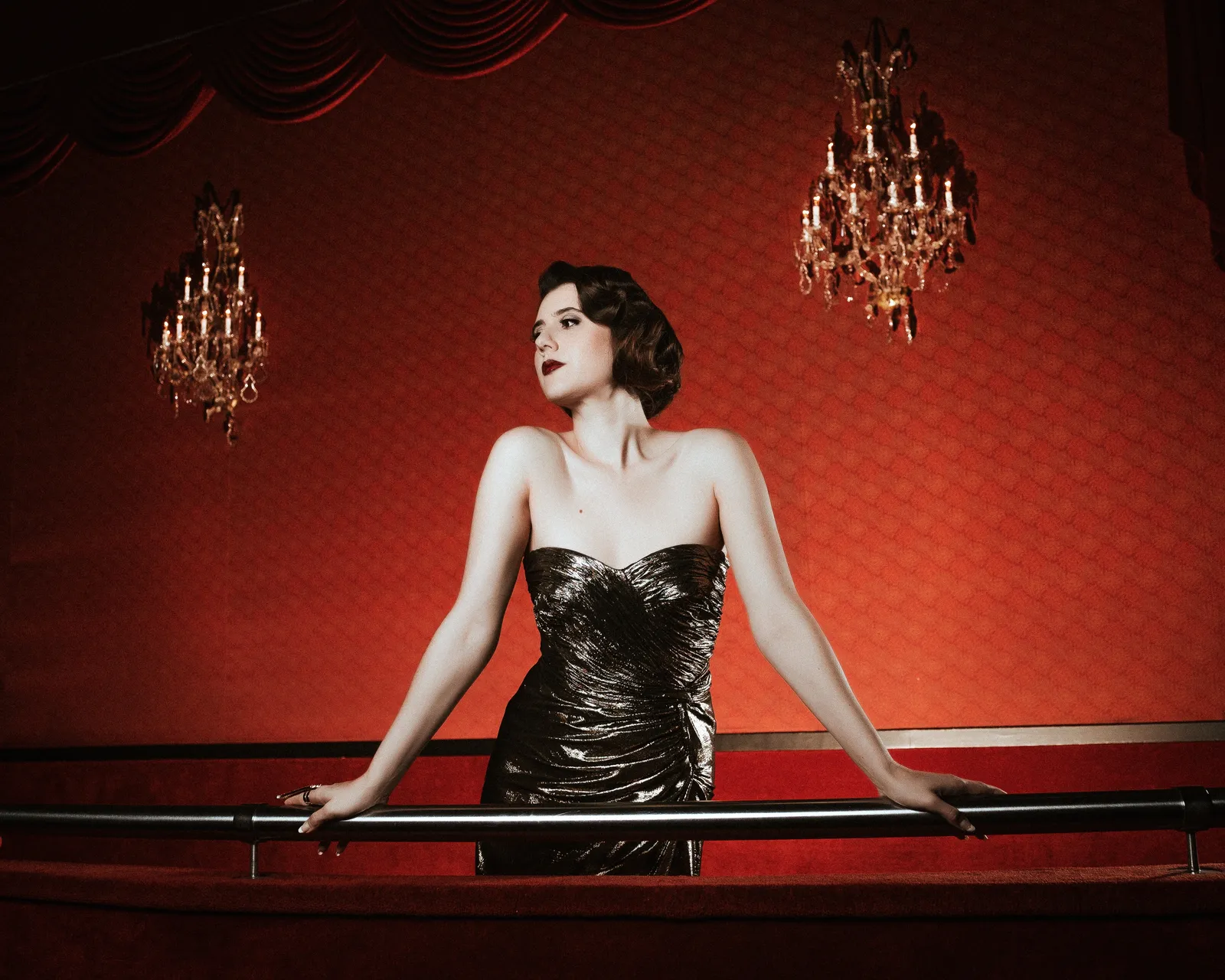Full interview with Hollywoodland News by Chau Le, Executive Vice President of Creative and written in collaboration by Regina Luz Jordan, Founder & Editor in Chief
Some records behave like products but Live at Joe’s Pub by Lizzy and The Triggermen behaves like a room that refuses to die after last call. For those who grew up in the theater, that room is church. It’s not pews or sermons. It’s a ritual made of breath and light where strangers agree to feel something at the same time. You arrive carrying the noise of the day but you leave carrying music in your ribs like you smuggled out a relic.
Live at Joe’s Pub is that feeling on tape. It’s not a clean museum copy or a fingerprinted document that tells you exactly who was there and why it mattered.
Lizzy and the Triggermen did not set out to make just another live album. They set out to play two sets in a room that knows how to listen.
They bought the recording package for promo clips and the universe laughed and handed them a record that will not sit quietly on a shelf.

HLN champions human artistry because the industry keeps pretending a feed can replace a feeling. For those of us invested in music and the industry, we already know it cannot. You cat automate the way a horn section answers a vocal the way a friend finishes a sentence. You cannot code the hush that falls before a ballad lands or the laugh that breaks a tense bar and lets the drummer lean back into the pocket. This band understands that the room is part of the instrument and they beautifully to it and with it. They invite it to sign the album.

Elizabeth Shapiro of Lizzy & The Triggermen fronts like a storyteller who trades in risk. She is not chasing pristine. She is hunting presence. Her band meets her there with charts that move like scenes and time that breathes. The triumph of this record is not polish. It is consent.
Ten people say yes to the moment and mean it. The audience says yes back. Them someone hit record and that is the miracle. It’s not trying to be perfection but giving permission.
This article sits in that space. It is not some big rollout and you can tell it never intended to be. This is more of a musical field note from a night that without the record might have evaporated. We dig into how the Lizzy & The Triggermen album happened by accident and why it feels inevitable. We talk about arrangement as narrative and engineering that rebuilds a stage for your ears so you sit in the heat instead of the cheap seats. We talk about ethics that pay musicians for real. We talk about why live still wins in a world that keeps trying to trade people for plugins.
“It wasn’t perfect. It was perfectly human.”
And that is the point.
the Room that Helped Write the Record
Lizzy Shapiro does not release music just to feed the scroll. “I’m somebody who does not rush to put out music,” she says and that standard shaped everything about this album.
I mean, I think that there’s this over-saturation of content right now, and I just don’t really want to put something out unless I really feel like there’s something in it that’s worth asking people to pay attention to, because everybody is demanding so much of people’s attention.
The first live capture of Lizzy & The Triggermen at the El Rey proved the point. The band played well but the recording failed.
“They recorded the whole first set, then the entire set break, so the memory filled up,” she says. “I have 30 minutes of the audience just milling.” They let that night go and kept working.

Live at Joe’s Pub by Lizzy and the Triggermen arrived as a practical decision. Two shows in a room with history and a paid option to record for promo clips. “Never in my wildest dreams did I think we would get anything more than a couple of YouTube videos out of it,” she says. The lineup was half Los Angeles and half New York. There was no rehearsal. “They met at soundcheck,” Lizzy says. “I knew I had stacked the deck with some of the most incredible musicians. I knew it would sound great, but I wasn’t thinking this would be recorded for posterity.”
The nerves were real. “Truly, any moment can ruin a recording,” she says. This time the moments held. “Song after song the band is on fire and so in sync, and yet also so loose and having so much fun.” What she heard was not a souvenir. “For the first time I felt like the sound engineer had captured what it sounds like to be at a Lizzy and the Triggermen show.”
Months later she finally pressed play on the Lizzy and the Triggermen live recording. She started with “La Vie en Rose.” Pianist Chris Dawson set the tone and the room felt present. Trombonist John Allred took a solo that held its line and the band landed together. “It sounded like a recording lost to history from some fabulous Parisian club in the 40s,” Lizzy says. “It sounded like an iconic recording to me.” That listen sent her through the rest of the night with intent.
“I didn’t want perfect. I wanted it to feel like you were sitting at our show.”
The decision to release started with people, not plugins. No one took the Joe’s Pub gig expecting an album, so Lizzy went back to every player first. “I wanted to be respectful of the musicians and make sure they were on board,” she says. “I also paid them extra, because what I offered was for a gig. It was not for a gig and a recording.” The answer was yes across the board, which turned a promising listen into a real plan.
You know, it’s very strange, but I feel like, as the world gets more upside down, that the way I can at least tether myself to reality and sanity is via human connection and trying to create experiences and spaces that recharge the human spirit.
The result is a record built on consent, credit and curation. It honors the players who made the night possible, the techs who caught it and the listeners who will meet it for the first time. Or as Lizzy puts it, “We did not plan this. We recognized it, then did right by the people who made it happen.”
Proof It’s Not AI or Why Live Still Wins
for Lizzy & The Triggermen
Lizzy does not frame the Lizzy and the Triggermen album as nostalgia the way that swing music can so often be wrongly pigeon holed. She frames it as proof that human connection still beats the feed. “We are in this odd moment where the tech industry is trying to replace humans with AI,” she says. “No matter how much money the billionaires sink into AI, no robot can do what those musicians did that night.” For her, the record is not an argument. It is evidence.
“Music is a profound expression of our humanness.”
She talks about it like a practice. “Music is how we describe the messiness of being human in a way that transcends words,” she says. “My church has always been theater and live performance. That is my ritual. That is where I have experienced transcendence as an audience member and as a performer.” The language is plain but the claim is big. Live music changes people and sends them back into the world a little better and Lizzy and the Triggermen play their own role in that.
Joy is not decoration here. It is the work. “I want shows that recharge people,” Lizzy says. She also names the exchange that makes it possible. “As much as I hope to give people a battery recharge, they do that for us.” Promoters notice it. After The Troubadour, staff told the band how good the crowd was. That kind of audience shows up ready to listen, then sends the energy back across the stage.
She is also clear about social media. It is useful, not a replacement. “We put so much focus on getting the perfect photo or the perfect video,” she says. “We get likes and comments, but that is not a connection.” Presence is different. “When it is really happening there is a magical energy exchange. You leave the show like you just got back from a vacation.” That is the effect she wants the record to preserve for people who cannot get to the room.
(When) Billie Holiday sings, and you hear the tragedy in her voice, you hear all of the patina of her life in her voice, and it’s beautiful. She’s able to take this tragedy and make it beautiful, and it makes us be able to see some beauty in our own tragedy.
Influences kept her honest about the bar. She remembers Prince at The Forum. “Witchcraft,” she says. She remembers Radiohead in a Roman amphitheater. She thinks of Audra McDonald and how a single note can carry a life. Those nights live inside her like fuel. “They are little energy bars,” she says. “I go to them when I need to recharge.” The album aims for that kind of usefulness. Not perfection. Usefulness.
The set list reflects that stance. Standards sit next to a pop surprise because surprise can open a door. “I hope it brings people joy,” Lizzy says. She wants first-time listeners to find an entry point, then come to a show and hear how the music changes the next night. A live record should invite you to the next chapter, not pin a butterfly to a board.
Range, Curation & What Comes Next
The Joe’s Pub set works because it shows the full reach of Lizzy and the Triggermen without turning into a medley. The choices are intentional. Standards sit next to a left turn so the night feels alive for first timers and loyal fans. Lizzy likes the surprise. She kept a pop cut in the running because it earns its place on feel, not novelty. The point is to open a door, then keep musical authority once you walk through.
Not every keeper stayed. Lizzy made calls with the long game in mind. A few originals that landed in New York will live on the next studio record. Others worked but did not beat the studio versions already in hand. “There were songs I love that I cut because I want to save them for our next studio album,” she says. “We did a version of Eve’s Lament which I love, but I did not love the tempo we played.” The bar is not good. The bar is right for this album.
“I hope it brings people joy, and I hope people still come and check us out live.”
That invitation keeps coming up. The live record preserves one night. The show changes every time. Lizzy wants the album to be a gateway, not a final word. “The great thing about jazz is that it is different every time,” she says. The big band has weight and color. The trio dates offer focus and space. Both are true to the same voice. Listeners can find their entry point and then hear how the book rewrites itself from stage to stage.
Lizzy and the Triggermen have internal roles keep that range coherent. Musical director Nate Kettner handles count offs so Lizzy can hold the room. Piano and trombone take key lines without crowding the lyric. Section players listen first, then lean in. That discipline serves the catalog plan. The studio work can chase the ideal version of a tune. The live record shows what happens when a room answers back and the band rides it.
Curation closes the loop. The sequence you hear is not a scrapbook. It is a record that welcomes new ears, respects existing fans, and sets up the next chapter. That is how you grow a band without losing the center. Lizzy calls it simple. Put songs where they make the most sense now, then build what comes next on top of a night that earned its place.
Handmade Cover, Human Core &
Art you Can Hold
Although the music is the star, the cover earns second billing because it tells you how to listen. Lizzy chose artist Ashley Urban on purpose. “I asked her to hand paint it,” Lizzy says. “I wanted it to be human again.” She ties that choice to the record you hear. “I didn’t want to turn the album into something that felt stripped of its humanity just so it would sound perfect.”
For Lizzy the package is part of the document. “Every aspect of the album is a celebration of human artistry,” she says. That is why the credits read like a map. Recording by Jon Shriver who knows the room. “He really knocked it out of the park,” she says. Mix by Keith Munson who rebuilt the stage in your headphones while Lizzy sat in. “I like to be involved. We made decisions about what stays and what drags.” Mastering that lets the air live. Musical direction by Nate Kettner so the engine stays steady while the frontwoman connects.
She thought about the listener’s hands as much as their ears. “I wanted the album to feel seamless so you would know what it was like to be at one of our shows,” she says. That value shows up in the liner notes that explain choices without turning into a manual, and in the moments of banter that earn their place. “You don’t want to burden a track with too much talking, but context helps, so we aimed for balance.”
“I’m proud to put my money where my mouth is and invest in humans in a moment when everyone else is running the other direction.”
The visual language keeps that promise because the paint has grain and the lines breathe. “I wanted the cover to match what you hear,” Lizzy says. “Real people made this on a real night.” The team carried that care into small decisions that matter. It’s in a clear type that names players with alt text that credits the art and the artist and a track list that follows the flow so a new listener can take the ride in order.
None of this is decoration. It is the same ethic that shaped the music. “We did not plan this,” Lizzy says. “We recognized it and then did right by the people who made it happen.” When the art, the credits, and the sound agree, a listener trusts what they are hearing. That trust is the difference between a souvenir and a record you live with.
Lizzy & The Triggermen Setting The Bar for Human Magic
Lizzy measures this record against nights that rewired her. She talks about them the way athletes talk about tape. It’s not nostalgia but standards.
Prince at The Forum is the first reference point. “Witchcraft,” she says, then laughs at how fast it flipped her. “Before he even opened his mouth he started with some obscure song, and I was in the nosebleeds. He walked out and eyed the entire arena and I was like, I want to have this man’s babies. This man is magical.” She went in as a skeptic who knew the hits. She left converted by presence, not marketing.
“Those performances live inside me like little energy bars.”
Radiohead in a Roman amphitheater sits right next to it. Different genre, same lesson about scale and detail living together. Then there is Audra McDonald, who turns a single line into a lived history. “Every time I have seen Audra,” Lizzy says, “I am reminded that one voice can hold a life.” These memories are not trophies. She uses them. “For the best shows I have seen, I can go into myself and find those performances and feed on them as nourishment.”
That is the bar she carried into Joe’s Pub. It’s not a perfect take but every take is a useful one, like a document you can go back to when you need proof that music still reaches people in the present tense. It is why she left human traces in the mix and why she kept moments that show the band listening to each other. “The studio album is the platonic ideal of what the song should sound like, a little superhuman,” she says. “I wanted the live album to be incredibly human.” She is not chasing shine. She is chasing the feeling that kept her in the nosebleeds long after the lights went up.
I don’t pretend to compare myself to those people, but I think that, in my own way, that’s what I’m aspiring to provide to people.
It is also why range belongs on this record. A standard like “La Vie en Rose” sits beside a pop turn because surprise is part of how a night earns its place. It allows new listeners in without apologizing for swing. It gives regulars a fresh angle on the band they follow. “I hope it brings people joy,” Lizzy says.
The Lizzy and the Triggermen
Set That Teaches You How To Listen
The Joe’s Pub set is a lesson in how Lizzy and the Triggermen builds a night. Standards sit next to a left turn so your ear stays awake. The point is not novelty. It is authority that welcomes surprise.
Lizzy names it plainly. “The eclecticness of the set list really makes me happy,” she says of Lizzy and the Triggermen. “You never know what you are going to get.” That mix is strategic. A familiar melody brings new listeners in. A pop wink proves the band can swing without losing bite. The contrast helps the charts read like scenes instead of a museum tour.
Variety only works if the center holds, so the arrangements do the binding. Horns answer the lyric. Time breathes. Solos serve the tune. The night moves with purpose from song to song, not because of tricks, but because Lizzy and the Triggermen are listening to each other and to the room.
“This album is a capture of the band in that moment in time.”
Call it swing if you like, but what Lizzy means is a time feel that breathes, sections talking across the stands, charts that take a corner without losing traction. “The band is on fire and so in sync, and yet also so loose and having so much fun,” she says. It is jazz because the conversation leads, not nostalgia.
She says the quiet part out loud. “The great thing about jazz is that it is different every time,” Lizzy says. “This album is a capture of the band in that moment in time, but if you come see us another time, it will be different.” That is not a disclaimer. It is the offer. Come hear Lizzy and the Triggermen rewrite its own sentences in real time.
It’s Community, Not Fans
WHen the Room Signs the Record
Lizzy resists the pedestal when it comes to Lizzy and the Triggermen. “Calling people fans feels weirdly hierarchical,” she says. She prefers community because the exchange runs both ways. Promoters clock it after shows and the room arrives ready, the band gives it back and the night leaves everyone lighter. That loop is why a 10-piece swing band makes sense in 2025 even when the math argues otherwise. It is also why this album exists. Enough people kept showing up that saving one night felt necessary.
As much as I’m hoping to provide this kind of battery recharge, connection, and joy for people, I also am trying to get that for myself, too.
She is candid about the work. Keeping Lizzy and the Triggermen, a band this size, on the road is a slog some weeks. Travel, charts, contracts, press, all while protecting the show. The answer is not to shrink the music to fit the spreadsheet. The answer is to keep building a room where people recognize themselves and want to return. That is how scenes survive. That is how records like this get made without a marketing plan telling them to.
This release proves what HLN backs every day. Human artistry has value you can hear. Credit it. Pay it. Put names where people can see them. If you love the document, meet the source. Buy the record. Show up for the next night. Bring someone who needs the recharge.
Lizzy and the Triggermen want you Take the Night With You
Live at Joe’s Pub is not a Lizzy and the Triggermen souvenir. This record remembers how a room felt and invites you into the next chapter. Lizzy and the Triggermen are not offering perfection. They are offering presence. The kind you carry out in your ribs like you smuggled a relic.
If you are looking for the line that sums it up, Lizzy already gave it to us. “Every aspect of the album is a celebration of human artistry.” The rest is simple:
People made this.
People are the point.
Now go be part of the next chapter.
Back humans & not algorithms
Support Lizzy & the Triggermen
At Hollywoodland News, we support people over platforms
Stream/Buy
Own it direct. Your dollars feed humans, not a feed.
Watch the VIdeo
Live cuts where the room plays too.
Tour Dates
Pick a night. Bring your bestie. Leave louder.


Leave a Reply